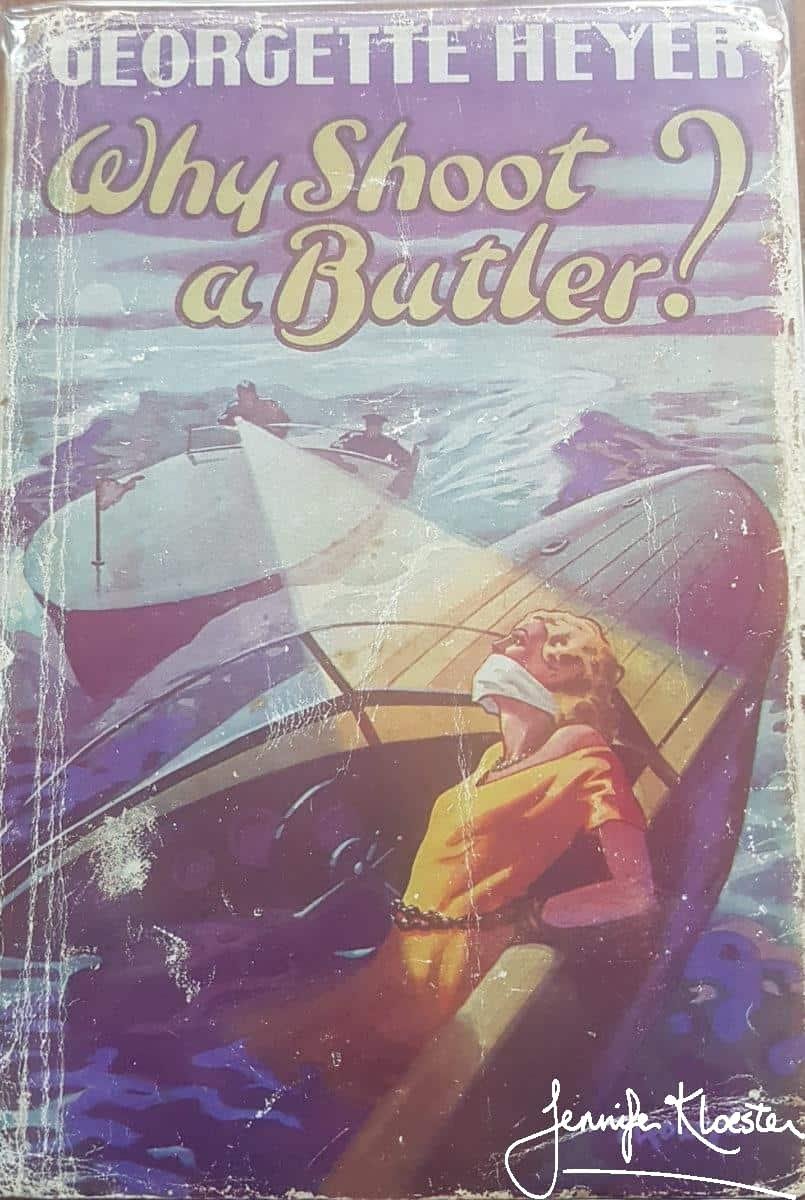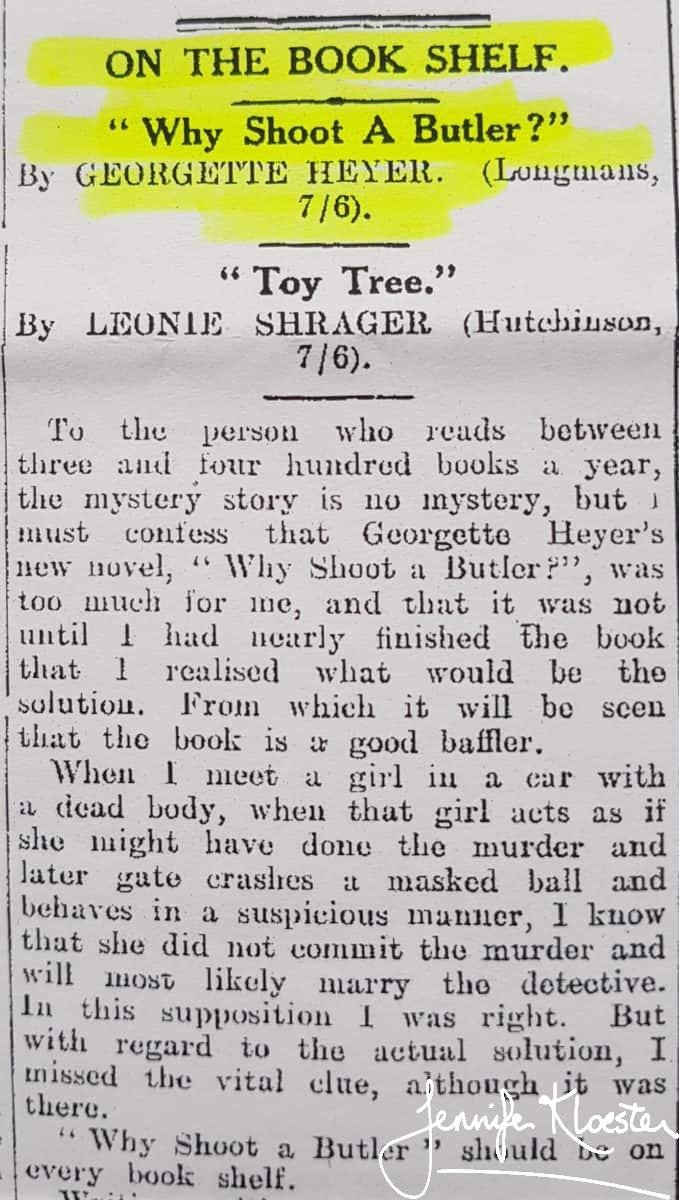
1932 – a landmark year
!932 proved to be a landmark year for Georgette Heyer. On February 12th she gave birth to her first (and only) child, a son, Richard, and on the very same day, Longmans published her first detective-thriller, Footsteps in the Dark. Thrilled to be a mother, but determined to go on writing, within months of Richard’s arrival Georgette had finished writing Devil’s Cub, the sequel to her bestselling novel, These Old Shades, and begun writing her second mystery novel, Originally called Half a Loaf – an obscure reference to the missing will upon which, in true classic detective style, the plot depends – Georgette wrote the novel with her accustomed speed and a great deal of verve. Her husband, Ronald, assisted with some of the more technical details to do with guns and cars and she eventually changed the title to Why Shoot a Butler? dedicating the book to Ronald with the enigmatic line ‘To One Who Knows Why’.

I have always enjoyed Why Shoot a Butler? which is one of those ‘curl-up-by-the-fire-on-a-wintry-day’ type of novels. Even more than Footsteps in the Dark Why Shoot a Butler? is a character-driven story with lots of witty dialogue and a hero-detective in Frank Amberley who is described early on as ‘the rudest man in London, an attribute or foible which, as one commentator noted, gave Heyer
‘an opportunity for wit, which is consistently entertaining, and even, in a couple of the books, carefuly worked into the plot…the conceit of Frank Amberley, who honestly considers himself far cleverer than the police or anyone else and is charming in spite of it in Why Shoot a Butler?‘
Nancy Wingate, “Georgette Heyer: A Reappraisal”,.
Amberley is one of Heyer’s clever men of means, a lawyer and, though arrogant, remains attractive and debonair. We like him from the first meeting when he is driving down a lonely road in his ‘powerful Bentley’ and comes across the lone figure of a young woman standing by a ‘closed Austin Seven’. This first encounter between hero and heroine is caustic, sardonic and compelling and becomes even more so when Amberley discovers a body in the abandoned car and a gun in the lady’s pocket – all by page five! There are hints here of novels and characters to come, but Why Shoot a Butler? is very much a stand-alone book in the Heyer canon. It was also her only publication in 1933, no doubt due to the birth of her son, the publication of two novels, the writing of a third and the move to a new home.
Secluded Southover
In September 1931, the Rougier family had moved from Swan Ken at Broadbridge Heath to a handsome, two-storey, furnished house, called “Southover”. Situated in the tiny hamlet of Lower Beeding, about 3.5 miles southeast of Horsham, Southover easily satisfied Georgette’s penchant for privacy, developed after her father’s untilmely death, and entrenched during her sojourns in East Africa and Macedonia. Southover, which still stands today, was at the end of a long, narrow lane, with only a few neighbouring houses and a solitary pub, the Dragon, nearby. It was very secluded, which suited Georgette, and it was here that Richard was born in February 1932 and here that she wrote Devil’s Cub and the book that would become Why Shoot a Butler? This second detective-thriller would be published in February 1933 with an advance of £300 and a request from Longmans for another mystery novel. This would be some time in the making, however, for in May 1933, Georgette and Ronald would leave Southover and once more start the search for a new home.

A “Golden Age” Novel
Why Shoot a Butler? was of the ‘classic detective’ variety popular at the time. The 1920s and 1930s were to become known as the ‘Golden Age of Detective Fiction’ and today Heyer is counted among the ranks of Golden Age authors (though it is Christie, Sayers, Allingham and Marsh who are considered the ‘Queens of Crime’). Even more than her first detective novel, Footsteps in the Dark, does Why Shoot a Butler? fit the style originated in 1878 by the ‘mother of the detective story’, Anna Katherine Green. whose influential novel, The Leavenworth Case, was the first novel in which
All the ingredients beloved by later writers of the school are introduced: the rich old dignitary, struck down just as he is about to make out a new will; the silent-footed butler; the body stretched prone in the library; the ballistics expert; and the coroner’s inquest with its detailed medical evidence.
Eric Quayle, The Collector’s Book of Detective Fiction, November Books, London, 1972, p.90.
A great cast of characters
Why Shoot a Butler? features a great cast of characters including a murdered butler, a suspicious heroine and a country-house party attended by an assortment of well-spoken county folk. Not only the hero, but also the overtly vague but very endearing, Lady Matthews, is blessed with unusual intelligence. Amberley has no time for fools and Lady Matthews sees through everybody. In a manner that belongs only in classic detective fiction, it is Amberley who directs the police, ordering them to watch over the heroine, Shirley Brown’s brother, Mark, and castigating them as often as he feels necessary. In the tradition of other amateur detectives, such as Holmes and Poirot, Amberley always knows more and far better than the local constabulary. It is unbelievable but it is of its time and it works. As one American reviewer notes:
‘In Why Shoot a Butler? ‘she captured every reviewer and most of the public with a couple of amoral characters, a special attitude towards crime, and a species of extremely dry fun, not to mention other necessary ingredients
Will Cuppy, “Mystery and Adventure”, New York Herald Tribune Books, 9 October 1938.

Family Connections – Norton Manor

Why Shoot a Butler? also featured a real house which Georgette had known of as a child. Her Aunt Inez used to stay with her in-laws at Norton Manor, a grand Victorian house in the deliciously named Norton Fitzwarren near Taunton in Somerset and Georgette had used it as a setting for her second murder mystery. Throughout her fifty-year career she would often use familiar locations such as inns and villages in Sussex or places she had visited and sometimes, such as when she had a character live in Albany, in places she had lived. Norton Manor, however, is one of the rare places which she knew first-hand and actually used as the main, rather than a minor, setting for one of her novels. It is a fascinating connection. Georgette’s own view of Why Shoot a Butler? is not entirely clear, but in a letter to her agent she wrote in typically self-deprecating (and very funny) style about a review she had read in a London paper. She erroneously named it the Westminster Record – perhaps confusing it with the Westminster Gazette in which her father, George Heyer, had occasionally had some of his poetry published. The original review clearly amused Georgette:
Somebody in the Westminster Record says that Why Shoot a Butler ought to be on every shelf. Now don’t burst into hoarse, mocking laughter. I’m taking myself very seriously. They talk about my “Art” in Horsham, & that sort of thing soon goes to one’s head. They can’t think how I make my people talk. They are sure they wouldn’t know what to make their characters say, & they wonder how ever I think out a plot at all. So do I. So when I next brighten your dull life with one of my gracious visits, just remember that I’ve got my Art, & can make my people talk, & ought to be on every shelf. No, I’m not sure that I like that last bit. After all, I did manage to lure Ronald into marrying me.
John Byers, The Record and West London News, 20 May 1933.

By 1941 Why Shoot a Butler? had been reprinted five times and easily earned out Georgette’s advance. In 1933 her agent, L.P. Moore had sold the serial rights for the story to Woman’s Pictorial but the formidable Dorothy Sutherland – the editor of both Woman’s Pictorial and the top-selling Woman’s Journal changed the novel’s name from Why Shoot a Butler? to Woman in Danger, without notifying either Heyer or her agent. Georgette was infuriated by the title but even more incensed by the insertion into her story of words she had never written. ‘Do you know they had the bloody cheek to make a character of mine use the vulgarism “la-di-da”?’ she told Moore’s assistant, Norah Perriam, ‘I am still furious.’ Today, Why Shoot a Butler? continues to sell and to entertain all those who enjoy a cosy, country-house mystery with an intense race-to-the-rescue finale not unlike the the desperate journey enacted by the hero of her very first novel, The Black Moth.

The 1966 Heinemann edition 
The 2006 Arrow edition




